by Thalia Vrachopoulos
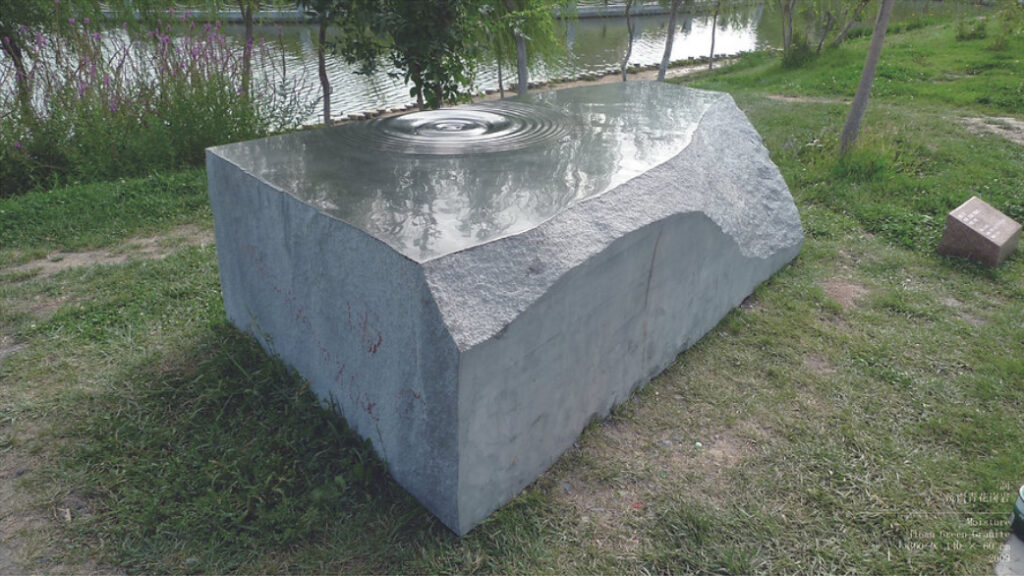
Lie-yi Shen works on his sculptural series for long periods of time, conceptualizing and finessing them while developing artworks in continuity. Many of his projects, as seen in Seesaw, (2012-21), Water Series (2001-21), Sky Series, (2012-19), Nest Series, (2004-21), can be discussed in terms of the Minimalist spirit in that they are repeated but gradually varied geometric artworks that use industrial materials. But Shen’s sculpture is different in the sense that he sometimes makes use of organic objects within them, starting a new work by adding various surprising components to his original piece. Because of this continued relationship and growth over time, in his work we can conclude that Shen has arrived at the mature stage of his career.
Spontaneity, randomness, or illogical juxtaposition were elements found in Dada and Surrealism; and they are also to be found in Shen’s Seesaw-Fading (2018), to which he added nature into the work, usually begun as a geometrically ordered piece. By using a bamboo bush as a central pivoting point of the Seesaw, Shen also juxtaposed the hardness of the Seesaw’s metal against the softness of a bamboo bush. In so doing, he contrasts the cold, manmade metal material of his sculpture against the organic, natural quality of the bamboo bush. Moreover, Shen has blocked the participants’ view with the bamboo plant, resulting in a situation that can be read as a political divide or the breakdown of communication.
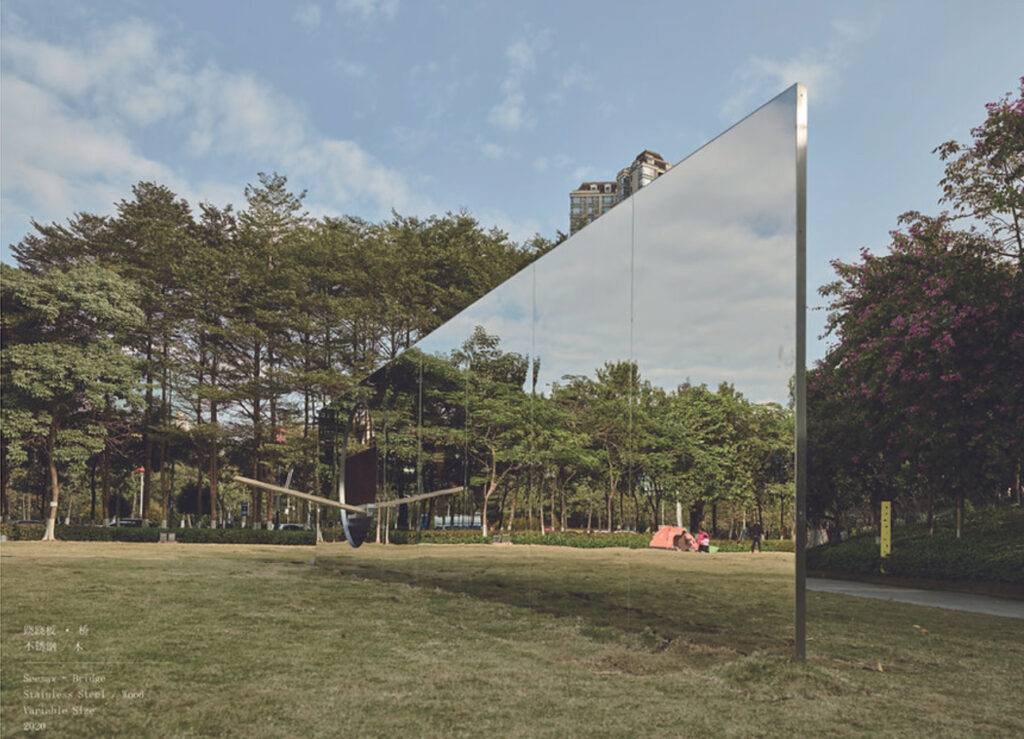
A similar unexpected juxtaposition takes place in Seesaw-See (2017), in which Shen divides the seesaw with a blue, reflective, electrified, switchable plate-glass partition. This screen contains LC film inside the glass, causing it to gradually transition from a transparent to an opaque state by simply turning on a switch located under the seesaw. As a result, the participants alternately see each other or the scene behind them. These changing views, depending on the extent of visibility permitted by the partition, result in the viewer alternately being able to see or not to see the other image.
The seesaw motif is close to Shen’s heart and is a subject he hopes to share with his viewers. While providing his work’s participants with a view of each other, he simultaneously gives them alternate viewpoints. During their interaction with his works, he hopes the viewers will perceive his ideas and share his concerns. In a traditional sense, when players ride a seesaw, their partner is visible. But Shen has added a central obstacle so that the players can barely discern, or simply not see at all, the other person. By blocking their view, he intends for the audience to perceive his attitude toward existence and nature, as well as the place of the human within them.
Shen lives a quiet life amidst the watery landscape of Hangzhou, China, near the Yiling Bridge, teaching and making art. He began exploring nature in his Water series started in 2001 where he examined the philosophical Daoist opposites of Yin/Yang or male and female principles. But, he also initiated a meditation upon the qualities of what he calls “celestial coalescence” by capturing the moment when a drop of water hits a surface. In modern East Asian cultures, theories of Daoism (based on obeying the way of nature or observing the correct path) are combined with those of Buddhism that in art relate to Chan (or Zen) esthetics. In the West, the Impressionists Edgar Degas, Claude Monet, and the Futurist Umberto Boccioni sought to represent the ephemerality of nature, for example, raindrops at the moment they are seen as falling, to both capture movement and to record the changing quality of nature. Shen does so by solidifying the forms created by water at the moment of hitting an object like a stone. Thus, he worked with granite carving, in response to which round water droplets would be formulated when hitting the rock, while at the same time alluding to the water’s glossy nature by recognizing its ability to shine. Actually, the idea of stone and water or hard and soft are part of this Yin/Yang theory of opposites, which also relates to the gongshi, or scholar rocks, found in nature and shaped eccentrically, and distinctively, through millennia of repeated water erosion. Shen’s Garden Meditation (2012) represents a scholar garden with gongshi rocks and flowing water that relates to the artist’s native Hangzhou, a city surrounded by mountains and water.
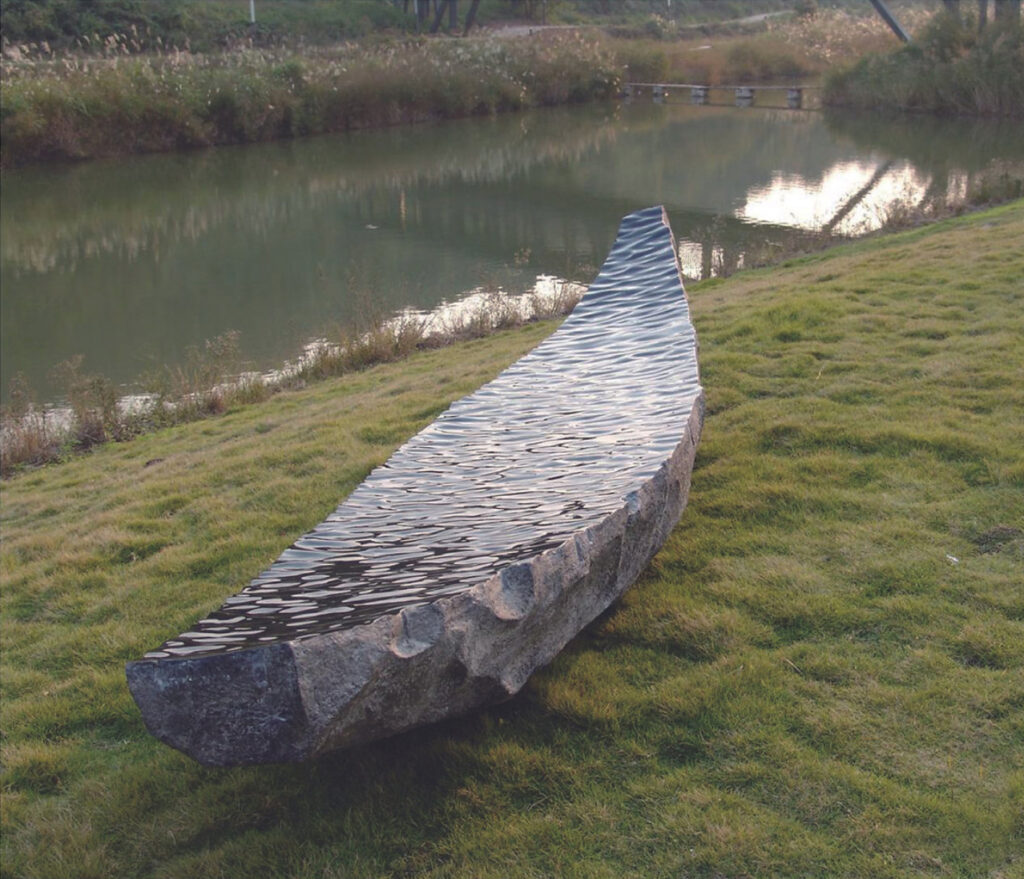
Related to his project Water (2001-21) is Boat (2005-16), a series made with rough-hewn black granite in the shape of a boat; its top glistens with water drops. There are a series of Dada-like elements found in this series that can be read as a rejection of social norms and society’s idea of progress. The heaviness of the granite material controverts the lightness and floating ability of a real boat. Moreover, the boat’s placement, perched on the grassy knoll next to the harbor, and its water content confound our normal expectations. We would expect to see a boat floating on water and not sitting on grass, just as we would not expect it to be filling with water but rather floating on it. Closer to Shen’s esthetics is the Chan Buddhist principle that relates to Dadaism in its spontaneity and use of contradiction; the concept is prominent in his Silent Water and Flowing Rock (2011-17). Here Shen maintains his interest in nature but, at the same time, confounds his audience’s expectations by situating the tree trunk horizontally and creating a shiny surface looking like water droplets diverting around a rock. Because of its uncommon orientation the trunk acts like the earth, as a backdrop for the rock, thus overturning traditional expectations while inducing the surprise element concomitant with the moment of Chan enlightenment, which strikes like lightning.
To a viewer unfamiliar with Asian esthetics, Shen’s investment in theories of dualism that embrace opposites–hard/soft, dark/light, organic/linear, thin/thick, hot/cold, and good/bad–may appear to be simplistic. However, despite the West’s opinion of dualist philosophy as Cartesian, it nevertheless informs Daoist tenets that embrace the idea that opposites are combined to create existence. In a similar manner, Shen creates his art by combining opposites to arrive at completion–not for the sake of resolution, but rather to accept his pieces as separate yet unified statements.
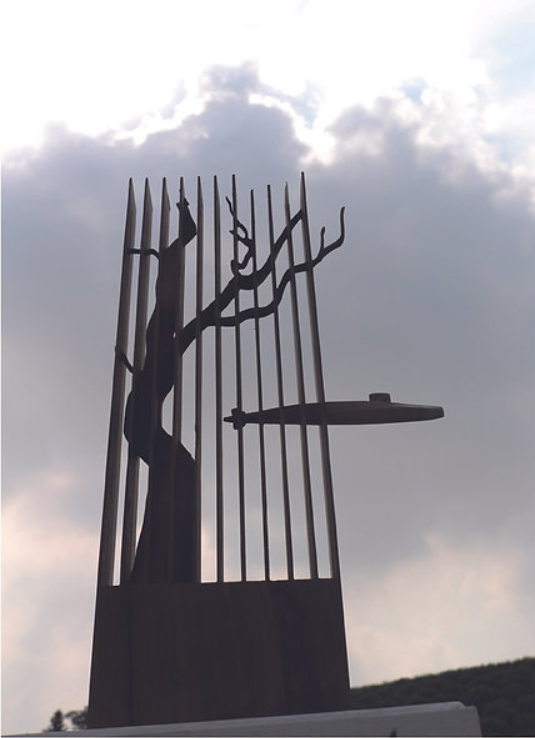
Especially noteworthy among Shen’s projects alluding to Daoist theories is the Nest series, begun in 2004. It is composed of three ovals, variable in size, that he suspended from a tree. Formed from woven bamboo, these containers are related in shape, coloration, and material to eggs and to nests. This organic architecture, seemingly suspended in the clouds, offers us a sensation of freedom and simultaneously adventuresome excitement due to its high, vertical orientation. In a sense it is also a hideaway or protective shell whose natural coloration enables it to fit without contrast into the background punctuated by trees. At the same time, the building behind the tree and its forms offers us a contrasting, manmade linearity that juxtaposes nature against culture. In his Ups and Downs, Wenge (2010), and the work Ties I through VII (2011-17), Shen created rectilinear vertical structures inhabited by natural forms. The straight bars signal confinement while the entrapped tree trunk in their midst, due to its organic nature, can be associated with humanity. It becomes clear that, taken as a whole, these projects reveal Shen’s love of nature, as well as warning against the incarceration/self-destruction of nature by humanity.
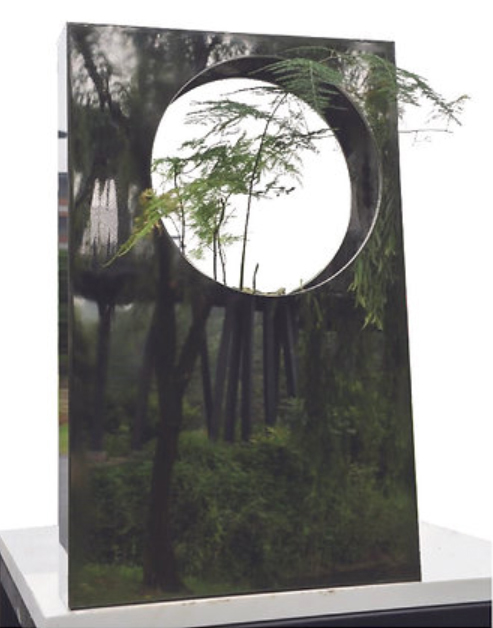
Shen’s title reveals the use of not just any tree but a Wenge or Millettia laurentis from Central Africa, a dark brown tree with black grain known for its straightness that makes it ideal for use in flooring and furniture. He references this particular tree specie because like nature, it is endangered. In his Ties series, Shen juxtaposes actual vegetation within metal, stone, or cement grid-like structures. For example, in Ties II, he incorporates metal pierced through its center by an actual pine tree, offsetting the tree’s predisposition to bend against the rigidity of the vertical iron bars. The pine is very important in Asian philosophy, and its symbolic implications for longevity and endurance are well-known. By using the pine, Shen is making the point that its longevity applies not only to humanity but also to nature in general: one cannot exist without the other.
As an activist, Ai Weiwei called attention to human rights violations, but Shen is after something else. He seeks to vitalize and preserve nature’s ecosystems. Making his art accessible to everyone, and noting that, through collaboration, the earth’s balance may be restored, Shen brings awareness of the earth’s delicate ecological balance. Thus, the artist hopes to bring about not only a greater respect for nature but also the embrace of social justice and remediation or preservation through public engagement.
